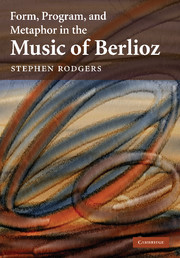Book contents
- Frontmatter
- Contents
- Music examples
- Figures
- Acknowledgments
- 1 Introduction
- 2 Preliminary examples and recent theories
- 3 Form as metaphor
- 4 Mixing genres, mixing forms: sonata and song in Le Carnaval romain
- 5 The vague des passions, monomania, and the first movement of the Symphonie fantastique
- 6 Love's emergence and fulfillment: the Scène d'amour from Roméo et Juliette
- 7 Epilogue
- Notes
- Bibliography
- Index
4 - Mixing genres, mixing forms: sonata and song in Le Carnaval romain
Published online by Cambridge University Press: 27 June 2009
- Frontmatter
- Contents
- Music examples
- Figures
- Acknowledgments
- 1 Introduction
- 2 Preliminary examples and recent theories
- 3 Form as metaphor
- 4 Mixing genres, mixing forms: sonata and song in Le Carnaval romain
- 5 The vague des passions, monomania, and the first movement of the Symphonie fantastique
- 6 Love's emergence and fulfillment: the Scène d'amour from Roméo et Juliette
- 7 Epilogue
- Notes
- Bibliography
- Index
Summary
Le Carnaval romain is one of Berlioz's most beloved pieces, and with good reason. Its taut construction and irresistible energy have made it a favorite in the concert repertoire. Berlioz thought highly of it and programmed it more than any of his other overtures. If one knows any work of his other than the Symphonie fantastique, one probably knows this overture and probably likes it – a generalization not so easily made about the Fantastique, which listeners to this day tend to find either intoxicating or infuriating and not much in between.
Despite its popularity, Le Carnaval romain has been discussed little in the analytical literature, particularly compared with Berlioz's other popular works: the Fantastique, Harold en Italie, Roméo et Juliette, La Damnation de Faust, and a work finally achieving the acclaim and attention it deserves, Les Troyens (1856–8). These are of course bigger pieces and thus demand more extended treatment (no one would expect a book-length study of Le Carnaval romain). Yet if one compares the number of articles and chapters devoted to their individual movements with the number devoted to Berlioz's most admired overture, the disparity is striking. Even Berlioz's less canonical overtures like Waverley (1827–8), the overture to Benvenuto Cellini (1836–8), and Roi Lear have fared better. Especially today, with Berlioz's bicentenary celebrations just past, it is surprising that Le Carnaval romain is still so untouched.
One reason for the relative neglect is that the piece and the issues it raises do not seem controversial.
- Type
- Chapter
- Information
- Form, Program, and Metaphor in the Music of Berlioz , pp. 63 - 84Publisher: Cambridge University PressPrint publication year: 2009



